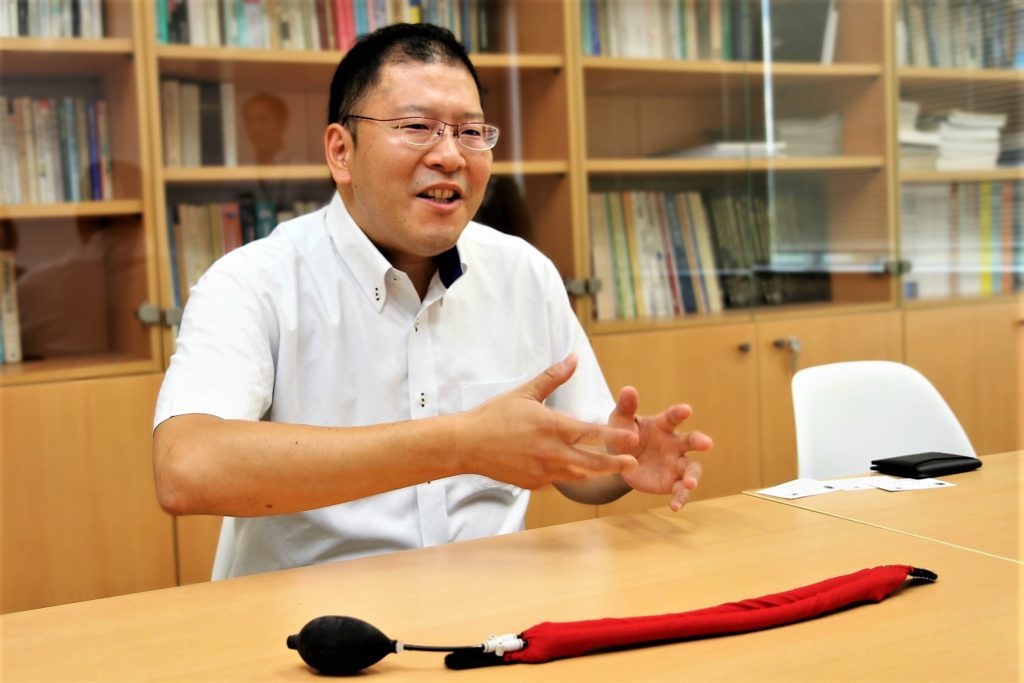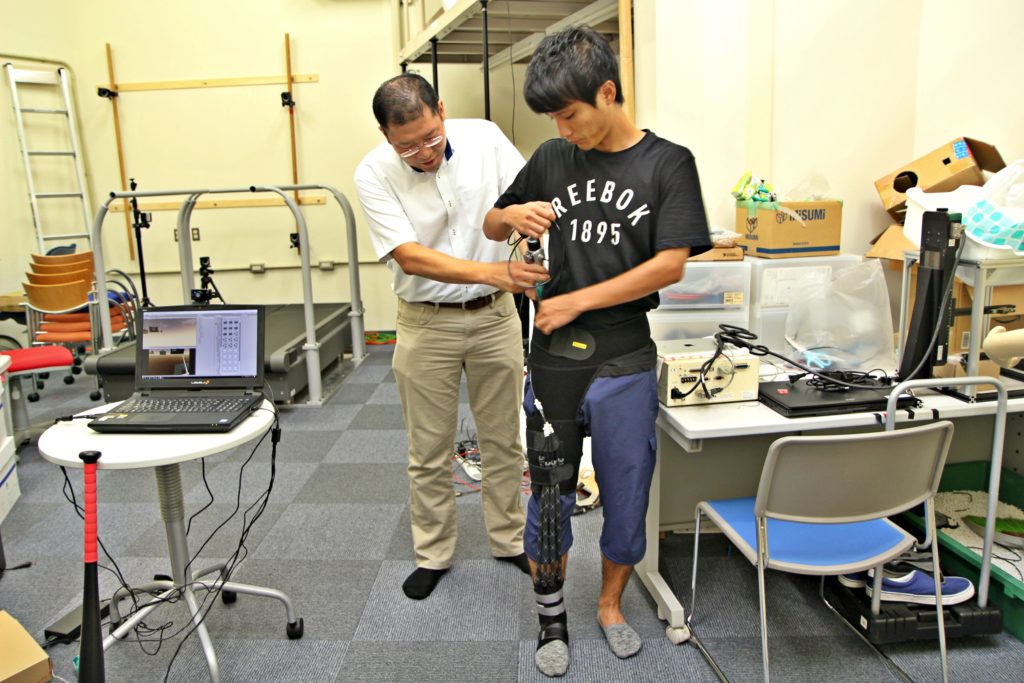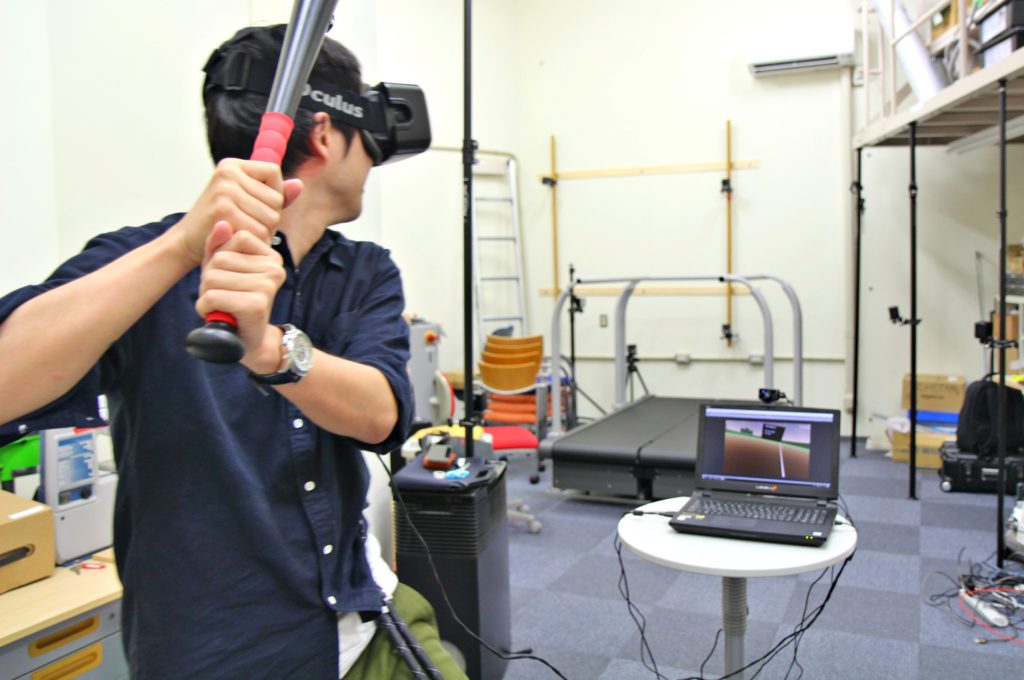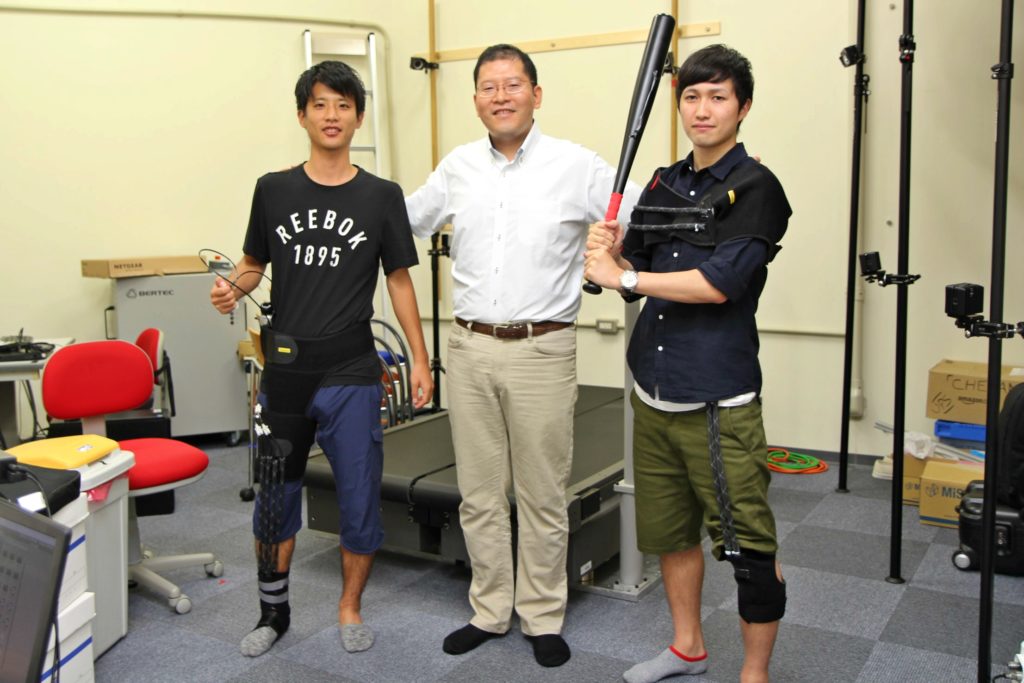
Professor Yuichi Kurita explains what makes up a soft exoskeleton powered by air pressure. (Photo: PR Group, Hiroshima University)
Yuichi Kurita never enjoyed sports. Now Associate Professor in the Department of Engineering at Hiroshima University, he thrives in pursuit of making sports more fun. An expert in robotics and virtual reality, Kurita is particularly interested in a kind of human-robot interaction called haptics, or the feeling of touch or force. He is using haptics technology to help all sorts of people, from patients in rehabilitation programs to players learning how to play baseball.
The 2020 Olympics are coming up soon. How do you see your research fitting in with it?
As part of the Superhuman Sports Society, we plan to hold some event during the Olympics to show the future of sports with augmented sports technology. However, I am even more interested in the Paralympics.
One of my research interests is human-machine interaction, and the Paralympics embodies that. Paralympians need to use some special device to do a sport, like a wheelchair or prosthetic leg. They need to know how to operate their device with their bodies in order to do an event, which is very interesting to me.
When we train athletes, we ideally should be tailoring programs to fit for individual motor and sensory capabilities. In this case, technology can assist people enjoying a sport more.
What trends have you seen with assistive technology?
We’ve worked with rehabilitation patients at Hiroshima University Hospital to help them do things like walk again with assistive technology we developed.
Patients have told me that rehabilitation can be painful, boring, or not very fun. And then, when they go home, it gets more difficult to practice. We can use robotics technology attached to the human body to make programs more fun and supportive toward recovery, as well as keeping good muscle health for a long time.

Yuichi Kurita helps one of his students Yuya Ishibashi put on his kick augmentation exoskeleton. (Photo: PR Group, Hiroshima University)
What kind of technology are you working on?
We are making wearable suits that we call “soft exoskeletons.” People tend to think of exoskeletons as robotic and involving wearing a heavy, rigid suit with electric motors. In order for them to work, they need big electric motors. That is why robots tend to be large and expensive to make.
Our exoskeletons are different. When our brain commands our muscles to contract, we can just contract them. It’s a similar idea with our soft exoskeleton. We figured out that by using pneumatic force, or air pressure, we could make a much smaller, lighter, and elastic device that is inexpensive to make. And, sometimes we don’t even need to use a motor, like in one device we use to augment the swing of a tennis racket.
This muscle device, which is made of three soft coils, straps around your forearm. When you provide air pressure – in this case, with tubing connected from the coils to a portable air cylinder – you can contract the muscle at the push of a button. When you press the button, about three kilograms of air pressure contract the coils and assists you in bending your arm. To make your arm relax, you just remove the air pressure. This technology can be used not only to assist, but also to augment a sports team.
Do you play any sports?
When I was a kid, I actually didn’t like sports! When I got older, I came to appreciate things like walking or jogging in the morning. Sometimes I play tennis or basketball with my students, but that’s about it. This is why I study sports. I want to change people’s experiences playing them with technology.
Many students in my lab play sports. When a new student starts working with me, I ask them to create something that they can use to enhance playing their favorite sports, and then explain how it is enjoyable.

Wataru Sakoda combines bioengineering and virtual reality to make an exoskeleton that helps people learn how to play baseball. (Photo: PR Group, Hiroshima University)
What sort of devices have your students made?
Two of my students like soccer and baseball, and they’ve each made devices to augment playing and learning these sports. Both are soft muscle exoskeletons you wear over one of your legs.
Before swinging their bat to hit the ball, baseball players need to do lift their foot at a precise time before the swing. Timing this timing step is important! Wataru Sakoda made a soft muscle exoskeleton that slips over the leg and gives the sensation of learning how to move the body. By using this suit, a new player can practice timing this step while wearing a virtual reality (VR) headset and practicing hitting a ball.
Yuya Ishibashi designed a suit to wear while playing football. Unlike Sakoda’s suit, which tells you when to lift your foot, Ishibashi’s suit is meant to augment your kick. We recently presented this product at an international conference called the Superhuman Sports Design Challenge. Teams develop new sports with technology and then demonstrate them at this conference, and then there is a competition to see which sport is most enjoyable.
Why is force feedback challenging to attain in a VR setting?
Our sense of force is not very precise in a VR setting. When we interact with an object in virtual reality, like picking up something, we don’t feel that interaction. That sensation could be realized by a force mechanism such as vibration. By combining visual information with force feedback, we try to design a feeling of the force.
What does it mean to be superhuman?
Sports games like Mario Tennis do not have realistic gameplay. You cannot serve a ball that smashes through the wall. If we use technology, maybe some of this could one day be realized. It might even be possible to augment the experience of spectators watching the sport, so that they can feel what athletes are feeling! For now, though, we are interested in improving people’s day-to-day life with assistive technology.
Many people already use technology that augments their abilities in day-to-day life! Take smartphones, for example. They are like an external memory. If we are connected to the internet, we can get any kind of information at our fingertips. Or, take eyeglasses. My eyesight is not so good. But when I use glasses, I can see.
Performance is objective, but feeling is subjective. Being superhuman does not necessarily connect to better performance. Practice is not always fun, but it does not always have to be that way. If people use our devices, maybe they will enjoy sports more. I hope physical assistive technology can change the world for anyone who wants to try sports.

From left to right: Yuya Ishibashi, Yuichi Kurita, Wataru Sakoda. (Photo: PR Group, Hiroshima University)
Originally written by Margaux Phares (Hiroshima University Science Communication Fellow)
Originally published on October 28, 2018

 Home
Home